Crispy deep-fried tofu served in a flavorful umami sauce, Agedashi Tofu is a popular appetizer you can find at izakaya and Japanese restaurants. It requires deep-frying, but the process is easier than you think. Skip the bonito flakes to make it vegan-friendly!
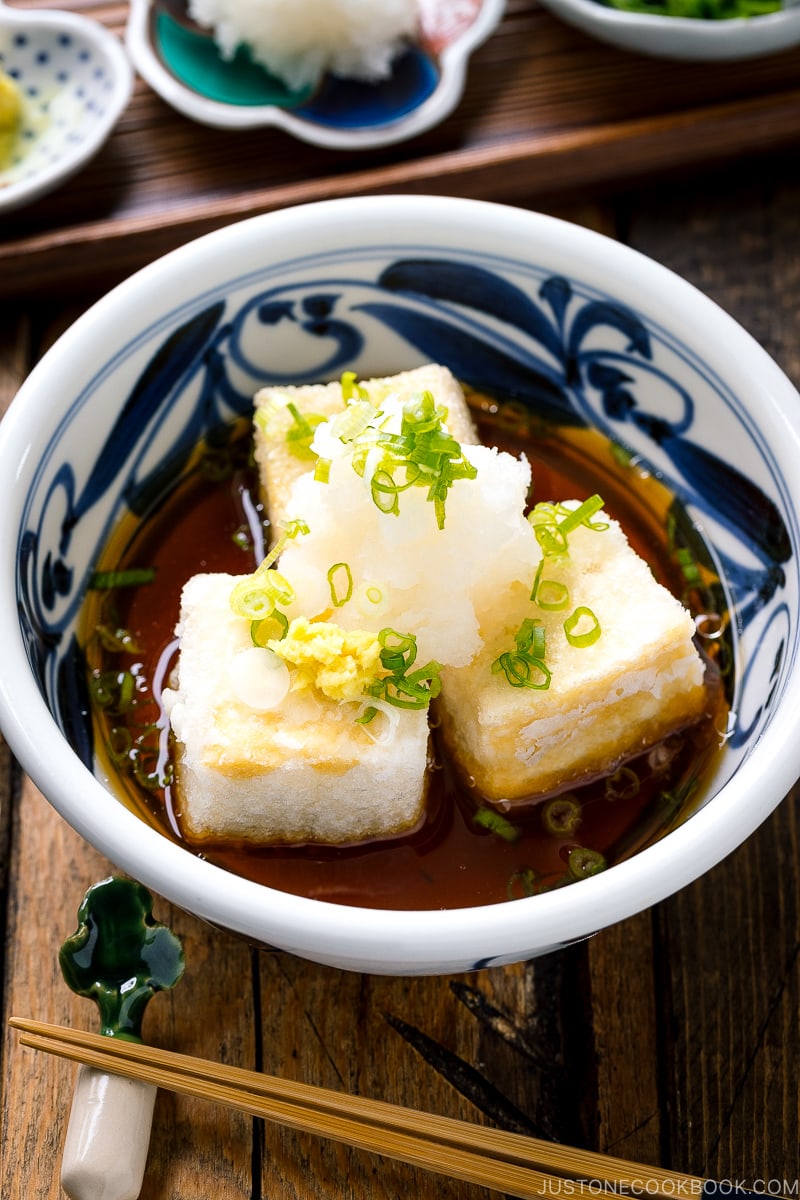
What is your favorite appetizer when you dine at a Japanese restaurant? Many JOC readers told me that they love ordering Agedashi Tofu (揚げ出し豆腐). Served in a sweet-savory broth, these lightly fried crispy tofu have an airy crunch and melt-in-your-mouth texture. So good that you wish you could eat the entire bowl yourself!
Agedashi tofu is actually not difficult to make if you don’t mind frying. I’ll show you a foolproof method on how to make this popular Japanese appetizer at home!
Table of contents
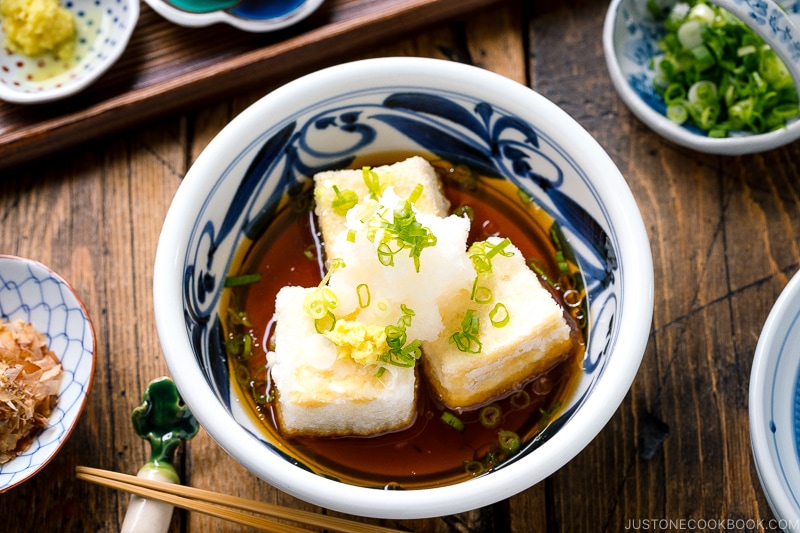
What is Agedashi Tofu?
Agedashi tofu, or what we call agedashi dofu (揚げ出し豆腐) in Japan, is made of soft or medium-firm tofu coated with potato starch and deep-fried so that the outer shell is crispy and the inside is smooth and custardy.
Right before serving, a warm tsuyu (sauce) is poured over the tofu to render an irresistibly umami flavor with a touch of sweetness. It is then garnished with a variety of toppings such as grated daikon, katsuobushi (bonito flakes), scallion, and grated ginger. For a spicy kick, you can sprinkle it with a light dusting of shichimi togarashi.
Served piping hot, agedashi tofu is arguably one of the most amazing tofu dishes one can ever have!
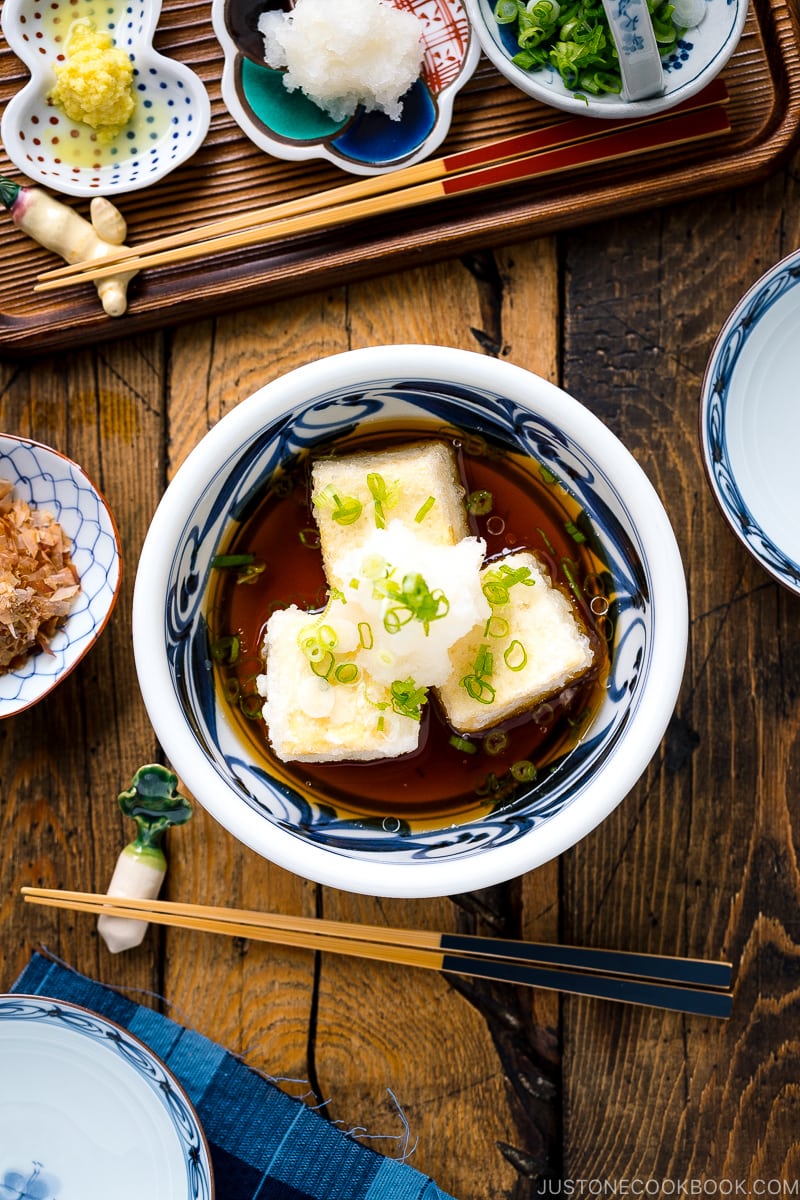
How to Make Agedashi Tofu
Ingredients You’ll Need
- Medium-firm tofu (momen dofu) or soft tofu (kinugoshi dofu) – If you’re new to making this dish, start with medium-firm tofu as it’s easier to handle.
- Potato starch – Please try getting potato starch instead of cornstarch (read more below).
- Cooking oil for deep-frying or shallow-frying.
- Tsuyu sauce: dashi (or use vegan-friendly kombu dashi), mirin, and soy sauce.
- Garnish: daikon radish, green onion, ginger, and katsuobushi (dried bonito flakes).
Overview: Cooking Steps
- Drain the tofu for 15 minutes. Don’t drain too long if you want the soft velvety texture on the inside.
- Meanwhile, make tsuyu sauce by combining dashi, mirin, and soy sauce.
- Cut the tofu block into 6 pieces (roughly 1.5-2 inch cubes) and coat them with potato starch.
- Deep fry the tofu for 2 minutes until lightly browned and drain the excess oil.
- Serve the tofu in a bowl and pour the tsuyu sauce. Garnish the tofu with grated daikon, chopped green onion, grated ginger, and bonito flakes.
How to Press Tofu
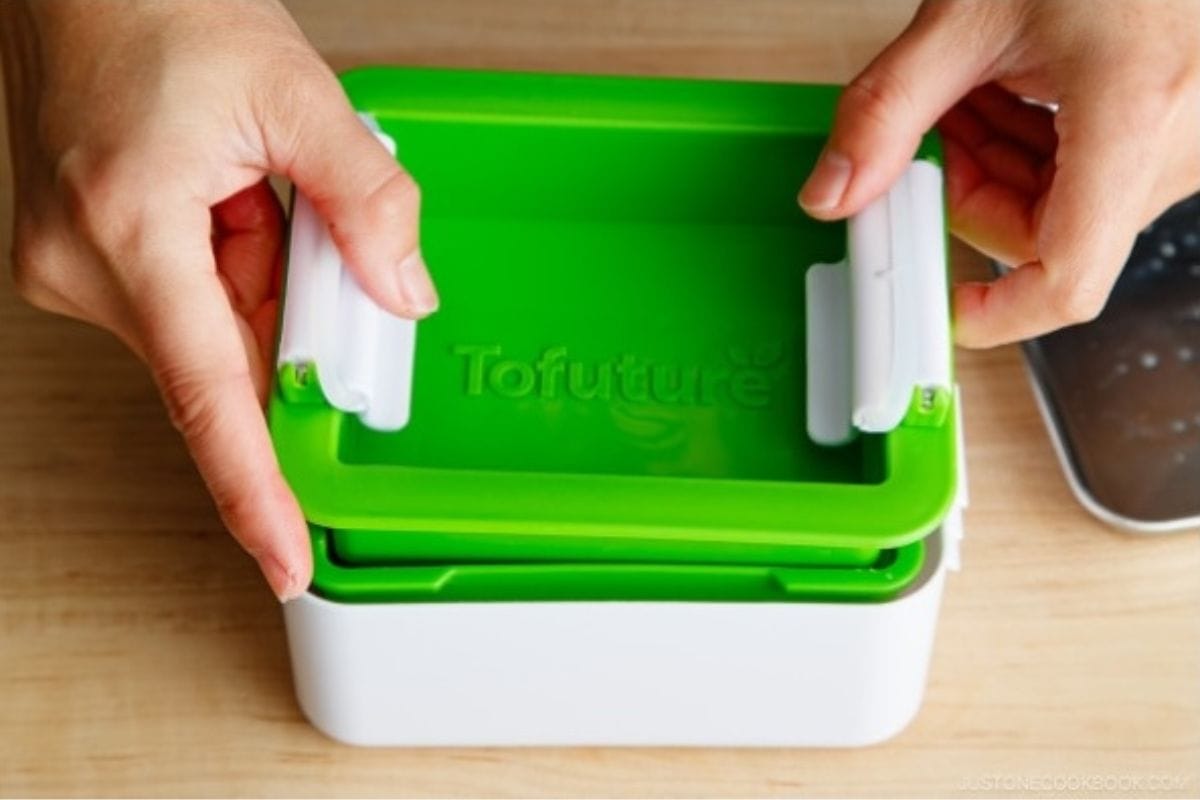
As you know, you can press tofu with a heavy object like a pot filled with water. However, I wanted to speed up the pressing time and make it more compact when doing this process, so I tried Tofuture Tofu Press and I wish I had gotten it sooner. It’s one of the best tofu presses because it’s easy to use and doesn’t take up much space.
Now, I don’t have to risk a heavy object falling while pressing my tofu and it takes up much less of my prep space. It drains tofu quickly, and you’ll only have to press it for about 15 minutes to make Agedashi Tofu. If you have been debating getting a tofu press, don’t wait—just get this one on Amazon for $22!
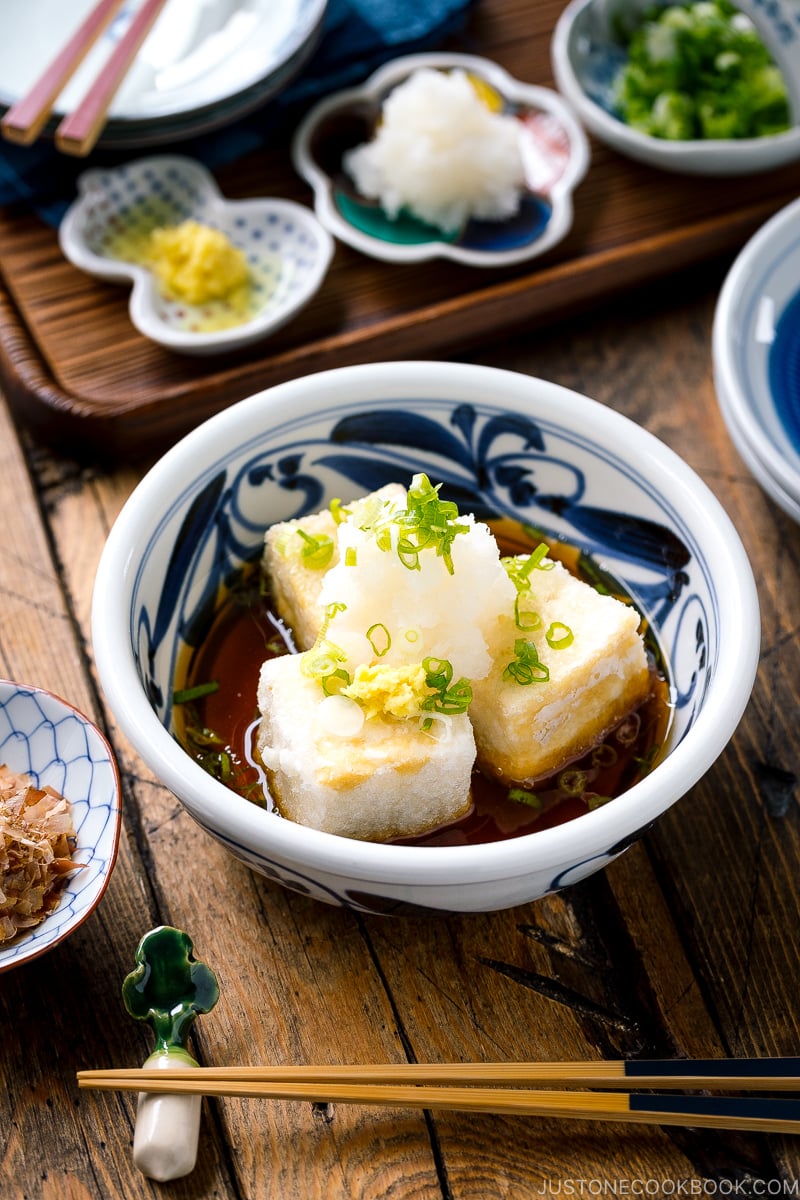
Know the Differences: Potato Starch vs. Cornstarch
In Japan, agedashi tofu is always made with potato starch or katakuriko (片栗粉).
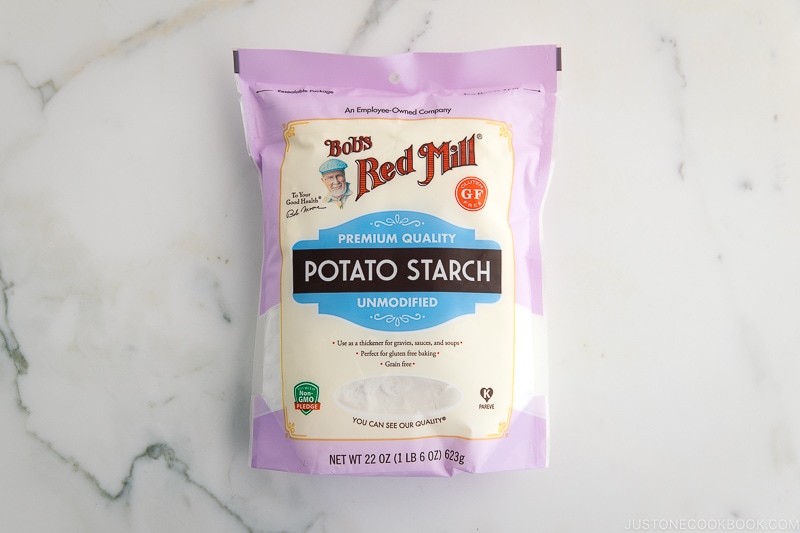
I’ve tried making agedashi tofu with cornstarch before and you definitely can use cornstarch. However, the texture is slightly different and a JOC reader once said it was very difficult to deep fry the tofu coated with cornstarch. Since cornstarch particles are much finer than potato starch, the coating just disappears as soon as the tofu is added to the deep-frying oil.
Another bonus is when we use potato starch to thicken the sauce, the color of the sauce doesn’t get altered by the potato starch as opposed to cornstarch that tends to leave its whitish crumbs.
So… it’s up to you. I buy potato starch from Bob’s Red Mill or a Japanese brand of potato starch from Japanese/Asian grocery stores
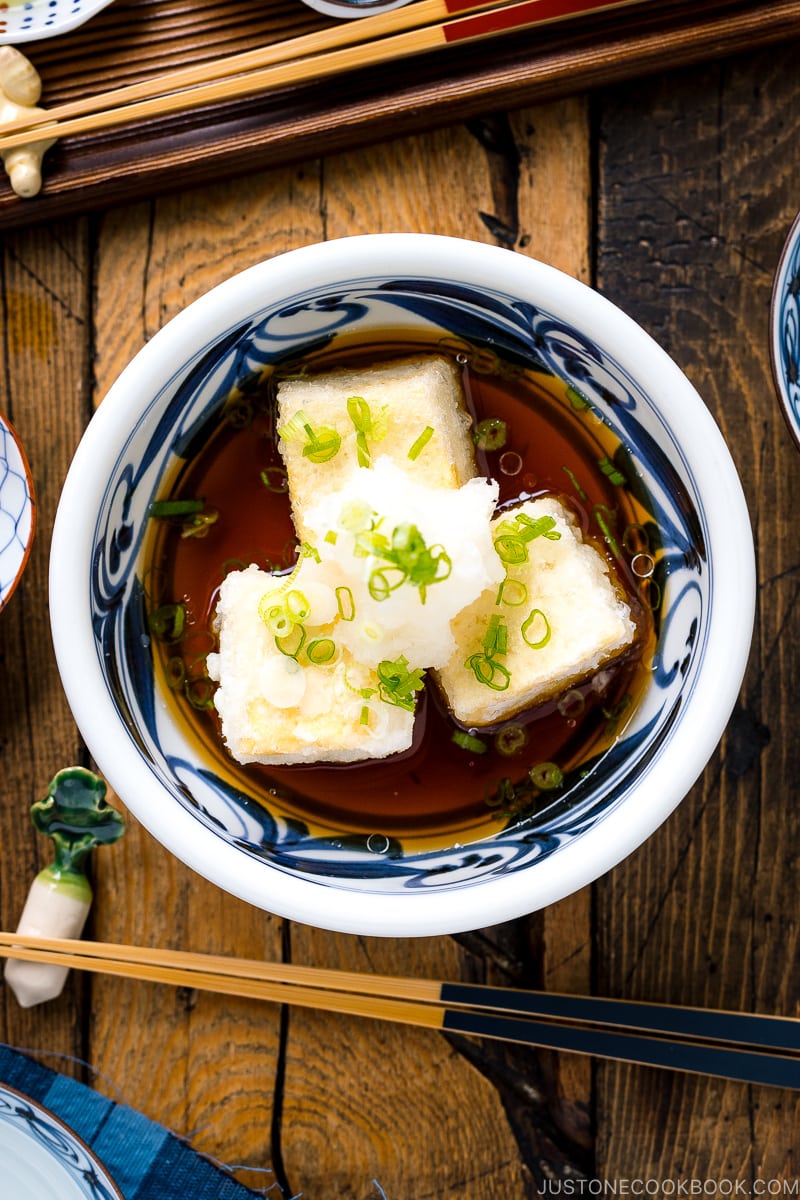
5 Important Cooking Tips
- Drain medium-firm tofu for 15 minutes, not too long, if you want a tender, soft tofu texture on the inside.
- Use potato starch if you really want to achieve the best texture.
- Coat the tofu with potato starch right before deep-frying. Don’t let it sit after you apply potato starch as the moisture coming out from the tofu will make the coating soggy and the crust may come off.
- Deep-fry at a lower temperature, about 320-340ºF (160-170ºC) degrees. Tofu contains a lot of moisture; therefore; it’s not recommended to deep-fry at high temperatures.
- Deep-fry in batches, so the tofu pieces don’t stick to each other.
Topping Choices for Agedashi Tofu
You can pick your favorites from the list below. Either prepare all of them or make it a fun topping bar.
- Grated daikon
- Chopped green onions/scallions
- Grated ginger
- Katsuobushi (dried bonito flakes)
- Shredded nori seaweed (kizami nori)
- Shichimi Togarashi (Japanese seven spice)
- Deep-fried lotus root chips
- Deep-fried shishito peppers
- Deep-fried eggplant (similar cooking method as this recipe)
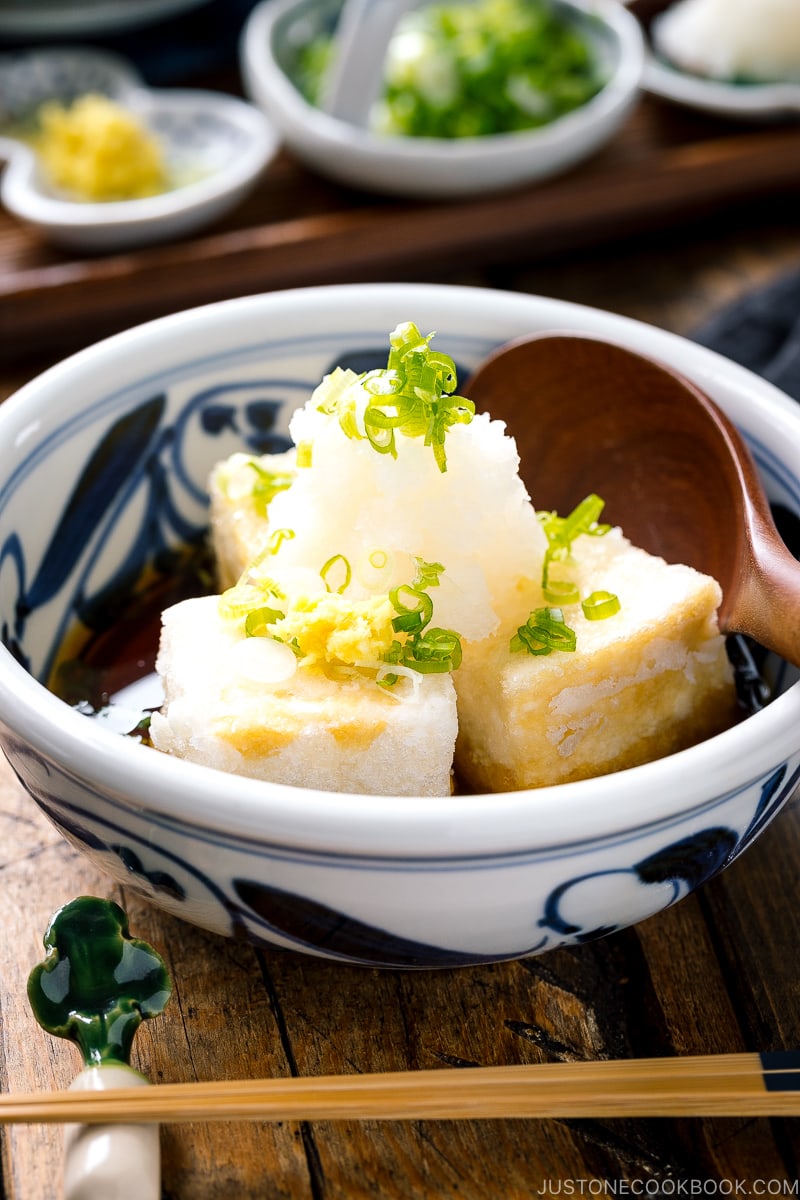
How to Make It Vegan
You can easily make it vegan:
- Use kombu dashi.
- Skip katsuobushi (dried bonito flakes) and substitute it with shredded nori for topping
If you enjoy making my agedashi tofu recipe at home, give us a rating or leave a comment to share your experience below!
More Popular Tofu Recipes on JOC
- Mapo Tofu
- Pan-Fried Teriyaki Tofu Bowl
- Green Bean Shiraae (Mashed Tofu Salad)
- Creamy Miso Pasta with Tofu and Asparagus
- Tofu Pizza
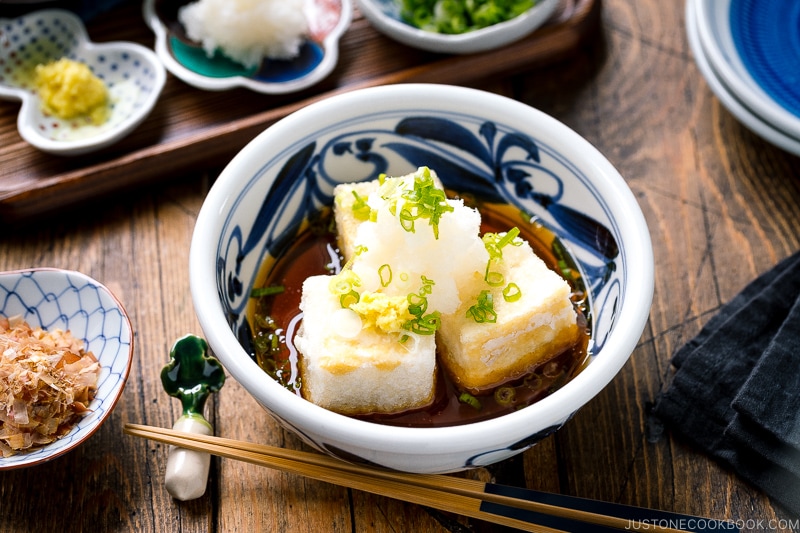
Wish to learn more about Japanese cooking? Sign up for our free newsletter to receive cooking tips & recipe updates! And stay in touch with me on Facebook, Pinterest, YouTube, and Instagram.

Agedashi Tofu
Video
Ingredients
- 1 block medium-firm tofu (momen dofu) (14 oz, 397 g; or use silken tofu)
For the Toppings
- 2 green onions/scallions
- 2 inches daikon radish
- 1 tsp ginger (grated)
For the Sauce (“Tsuyu“)
- 1 cup dashi (Japanese soup stock) (use standard Awase Dashi, dashi packet or powder, or Vegan Dashi)
- 2 Tbsp soy sauce
- 2 Tbsp mirin
For Deep-Frying
- 2 cups neutral oil (enough for 1 inch (2.5 cm) of oil in the pot)
- 4 Tbsp potato starch or cornstarch
For the Garnish
- 1 package katsuobushi (dried bonito flakes) (optional; skip for vegetarian)
- shichimi togarashi (Japanese seven spice) (optional, for a spicy kick)
Instructions
- Gather all the ingredients. If this is your first time making this dish, use medium-firm tofu instead of the soft silken variety since it‘s easier to cook without breaking. If you prefer a silky texture, give silken tofu a try once you‘re more comfortable making Agedashi Tofu.
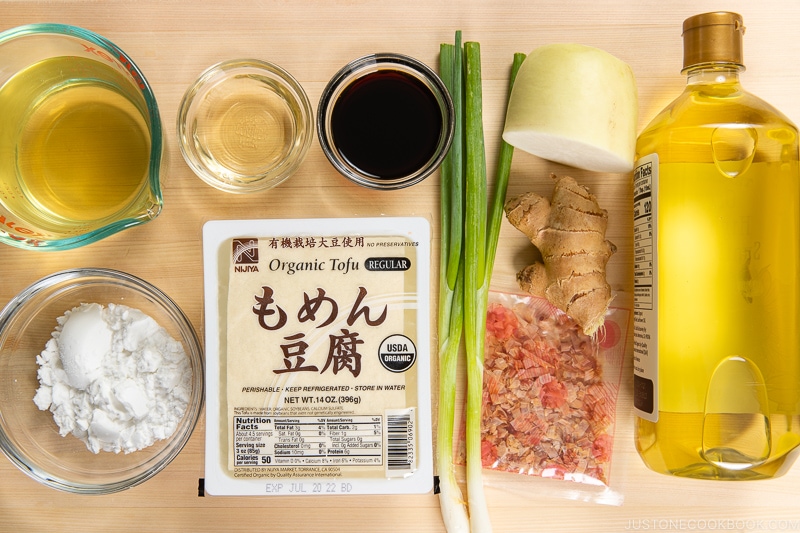
- Place 1 block medium-firm tofu (momen dofu) on a tray or plate. Wrap the tofu in 2–3 layers of paper towels and place another tray on top. Set a heavy object on top to press the tofu. Drain the water out of the tofu for 15 minutes.
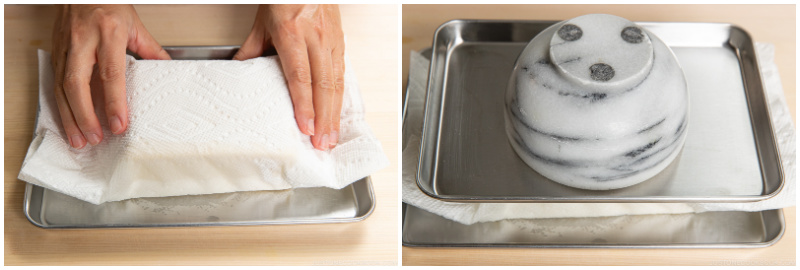
To Prepare the Toppings
- Cut 2 green onions/scallions into thin slices. Set aside.
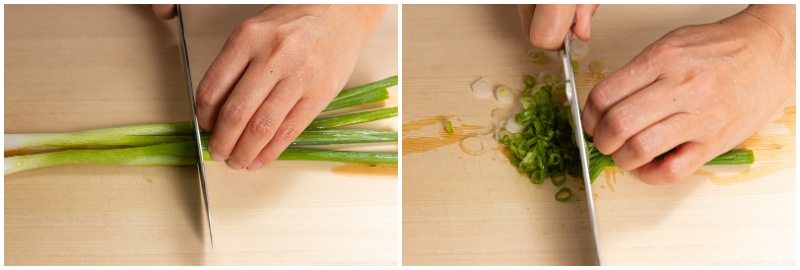
- Peel and grate 2 inches daikon radish (I use a ceramic grater).
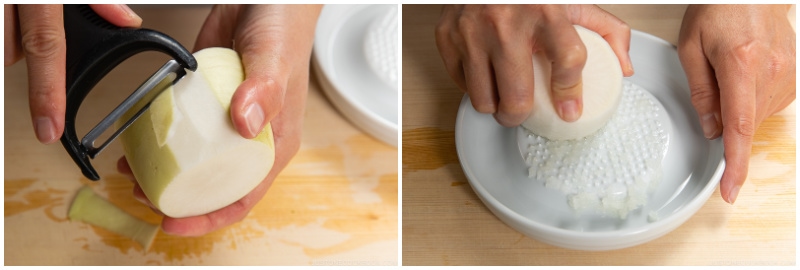
- Gently squeeze most of the water out of the grated daikon, keeping some moisture. Set aside.
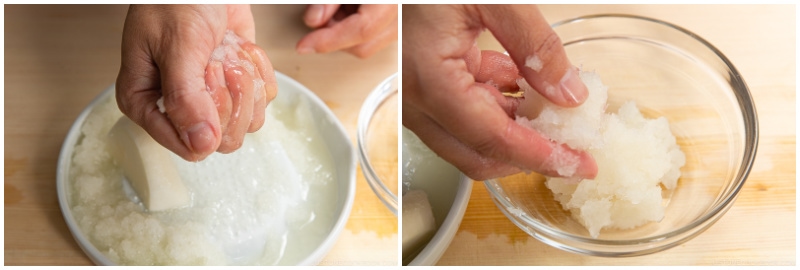
- Peel and grate the ginger. You will have roughly 1 tsp ginger (grated, with juice). Set aside.
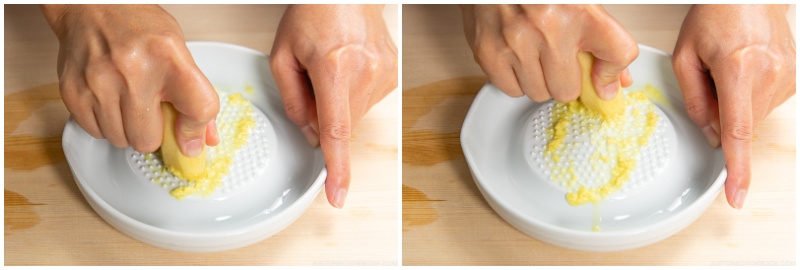
To Make the Sauce (“Tsuyu“)
- Add 1 cup dashi (Japanese soup stock), 2 Tbsp soy sauce, and 2 Tbsp mirin to a small saucepan.
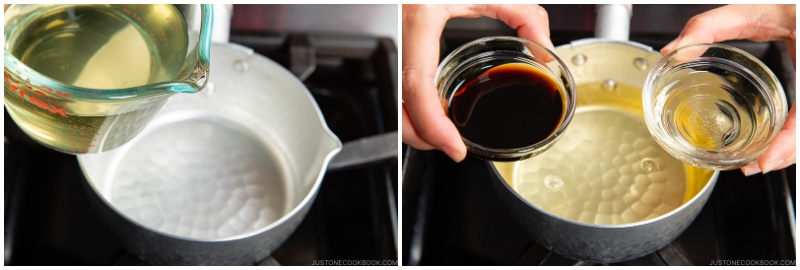
- Bring to a simmer. Then, turn off the heat, cover with a lid, and set aside.
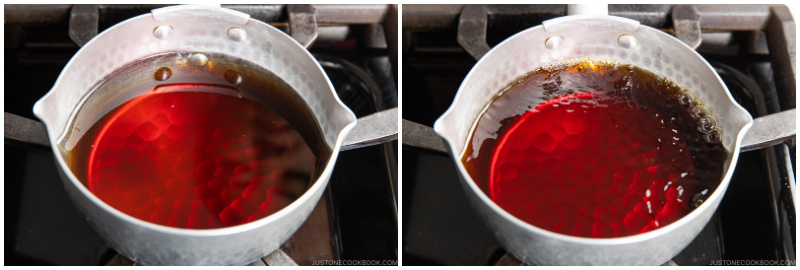
To Deep-Fry
- Heat 2 cups neutral oil to 320–340ºF (160–170ºC) degrees in a deep fryer or medium pot. Make sure there‘s about 1 inch, 2.5 cm of oil in the pot. Remove the paper towels from the tofu.
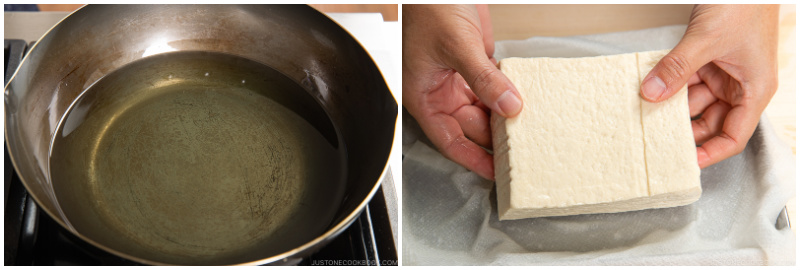
- Cut the 1 tofu block into 6 pieces.
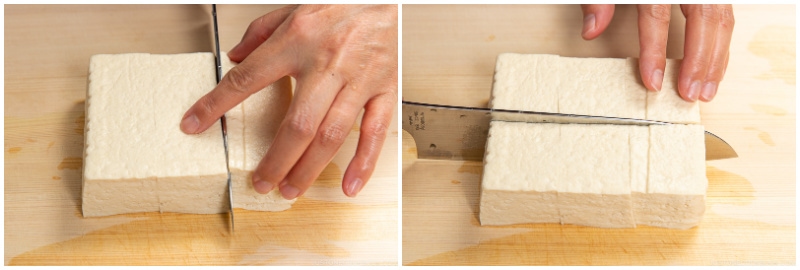
- Coat the tofu pieces with 4 Tbsp potato starch or cornstarch, dusting off any excess.
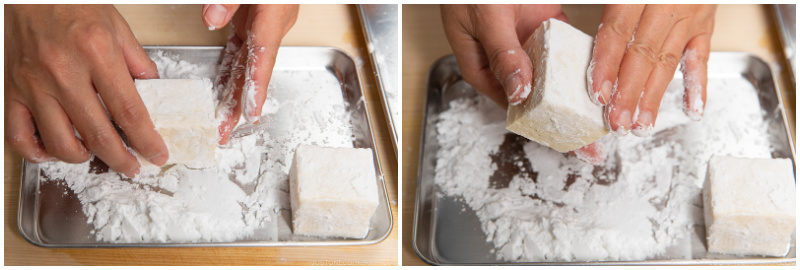
- When the oil is hot, add the tofu pieces in batches. Here, I add 3 pieces at a time. Be careful not to overcrowd the pan or the oil temperature will drop. Deep-fry, turning once, until they are light brown and crispy.
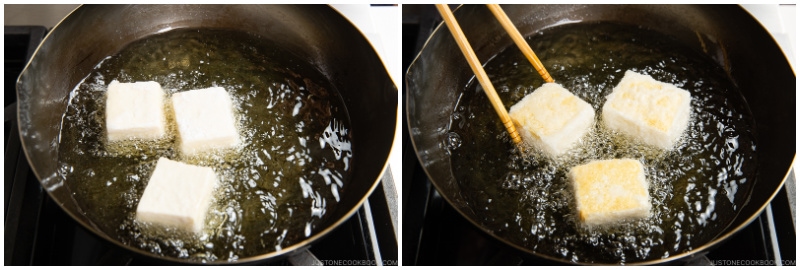
- Remove the fried tofu pieces from the oil and place them on a wire rack or a plate lined with paper towels to drain the excess oil. Continue to deep-fry the remaining tofu pieces. Then, place the fried tofu in individual serving bowls.
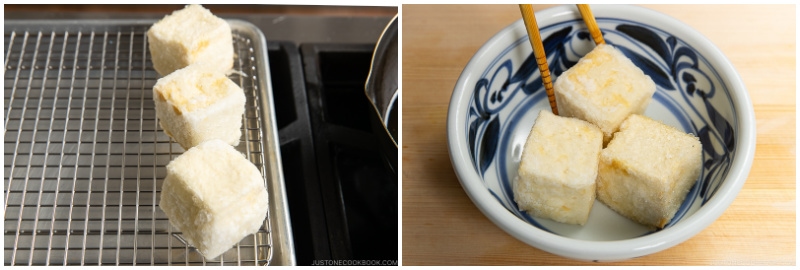
To Serve
- To serve the Agedashi Tofu, gently pour in the sauce at the edge of each bowl without wetting the top of the fried tofu. Top with some grated daikon, grated ginger, and green onion slices. For optional garnishes, sprinkle with 1 package katsuobushi (dried bonito flakes) and shichimi togarashi (Japanese seven spice).
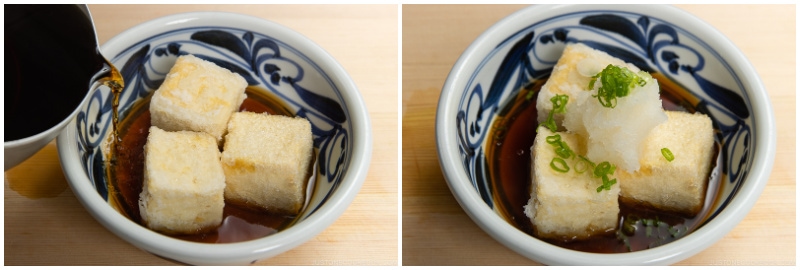
To Store
- You can keep the leftover sauce and fried tofu separately in airtight containers and store in the refrigerator for 3 days.
Nutrition
Editor’s Note: This post was originally published on June 13, 2011. A video and updated images were added on April 30, 2014. The post has been updated with new images and content on June 28, 2022.
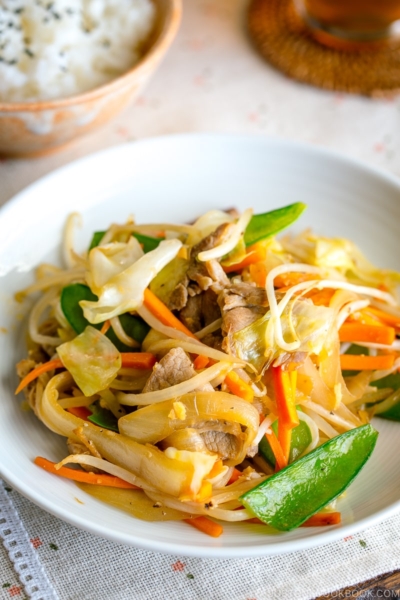
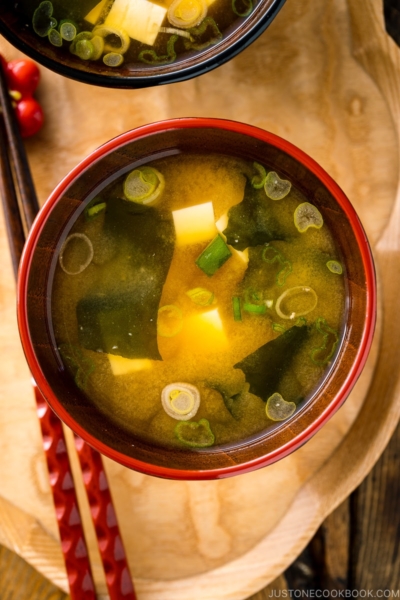
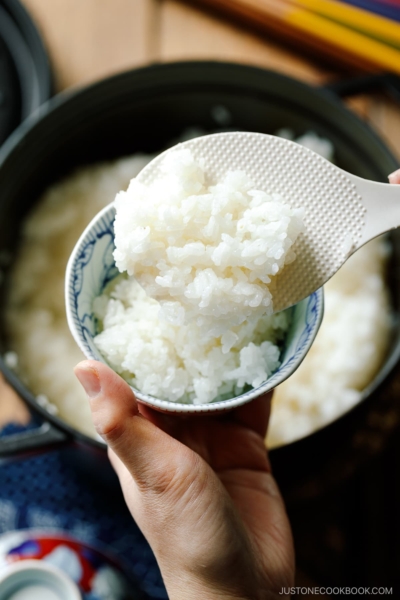
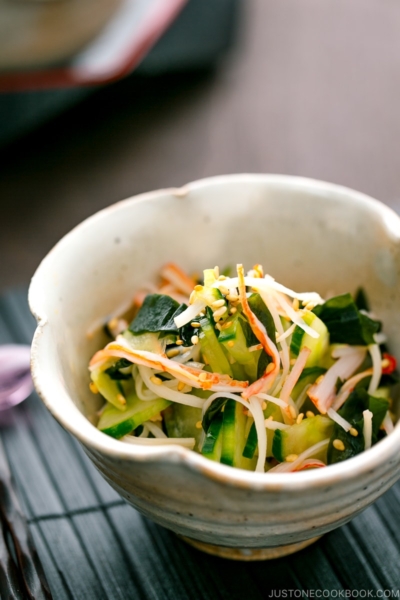




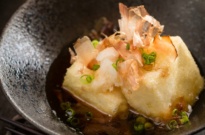
Hi Nami,
Big fan of your recipes! Had a question about this one. I’m trying to make the Agedashi Tofu for an upcoming izakaya-party in three weeks. To spread the cooking time – cooking in advance as much as possible – I thought to fry the tofu a few days in advance, store them in the fridge, and make the Tsuyu separately on the day itself (also to ensure that the dish is atleast a little warm). Do you think that would work, or would you propose another method?
Thank you so much in advance, and have a nice day!
Hi, Rik! Thank you for reading Nami’s post and trying out her recipe!
Izakaya party sounds wonderful! To prepare this dish ahead of time, we recommend making the Tsuyu the day before. And fry the tofu on the day. You may also cut the tofu the day before. Tsuyu can be reheated while the tofu is frying. In this way, the tofu texture will be crispy.
We hope this works for you!
Dear Naomi,
Thank you so much! Will try that 🙂
Ohhh this was delicious! I love agedashi tofu so much, it’s nice to finally have a recipe to make it at home, and knowing I made it myself somehow makes it even tastier! I may have gone a bit overboard and had the entire tofu block just for myself, alongside some rice and steamed broccoli – very full now, but zero regrets!
Hi, Cristina! We’re thrilled to hear that you loved Nami’s recipe.
Thank you for trying it and for your kind feedback. Happy cooking!
Turned into a pile of goop, literal starch goop.
Hi Jake, Thank you for trying Nami’s recipe.
We’re sorry to hear that your Agedashi tofu did not turn out nicely this time. It could be due to the oil’s low temperature or because the tofu was overly starched. We hope Nami’s 5 Important Cooking Tips in this post help you achieve the best texture of this delectable dish on your next attempt.🫶🏻
Wonderful! Japanese restaurants here rarely serve agedashi dofu and I really wanted to eat some, and with this recipe it came out perfect! I had set half my tofu block aside for later frying, but after eating the first batch, it was so good that I took out the remaining tofu to fry it too and ate it straight away!
I used Morinaga brand Firm Silken tofu (the one that comes in a blue carton) and it was very easy to handle.
Hi, Mathilde! We’re so glad you loved Nami’s recipe!
Thank you so much for trying her recipe and sharing your experience with us.
Happy Cooking!
I have what I think is a very basic question about how to make dashi broth. I am using the Hon Dashi brand dashi mix, and I usually simmer some sort of dried seaweed, then add the Hon Dashi. Am I making this correctly? What is the best way to use the Hon Dashi mix to make decent dashi?
Hi Joyce! If you are using Hon Dashi powder, we recommend checking out this post: https://www.justonecookbook.com/dashi-powder/
Many other ways to make Dashi can be found here: https://www.justonecookbook.com/how-to-make-dashi-jiru/
We hope this helps!
We loved this! We had it as an appetizer to your Yaki Soba, and it really was a delight! Between the two of us, we only used 1/2 block of tofu, and I made up the rest for dinner tonite. I used low sodium soy sauce the first time, and have added salt tonite, because I think salt brings out the other flavors.
Thank you for another great Japanese dish that even a gringo like me can make. (I do know what gringo means, but do not know the corresponding word for non-Japanese cooks!)
Hi Joyce! Thank you so much for trying Nami’s recipe and for your feedback!
We are glad to hear you enjoyed the dish.
Happy Cooking!
I made this too! Added mushrooms. Tastier than I thought it would be! I am trying the simple stuff first. Trying to gain some confidence for the more complicated recipes.
Hi, Lisa! Thank you very much for sharing the picture! It looks delicious! We also see Nami’s cookbook! 🤩
Thank you for experimenting with her recipe and sharing your experience with us. We hope you enjoy many recipes!
I was wondering if you could include some tips for making this with silken tofu, as that sounds delicious but I’m not sure if the method would be exactly the same; for instance, do you still need to press it, since it seems like that would risk crushing such a delicate block of tofu? Thanks!
Hi Sas, Thank you for reading Nami’s post and trying her recipe.
Yes. You can use the same method for silken tofu. You can also try microwaving it for 2 minutes at 600 watts to remove the moisture from the tofu.
We hope this helps!
Though I rarely deep fry, I have made this dish when frying up fish cakes to keep for Oden making. The recipe came out perfect on the first try. It may sound counter-intuitive to put crispy tofu in wet broth, but something about it is just surprisingly magical. Try it!
Hi John, Thank you very much for reading Nami’s post and trying her recipe!
We are glad to hear you enjoyed Agedashi Tofu.😊
I have a question. At 0:53 in the video, you pour something over the age dashi tofu. It looks like the dashi/mirin/soy sauce mixed with “something.” Is that something more of the grated daikon?
Hi Barbara! Thank you for watching Nami’s video and trying her recipe!
The sauce is from the bigger dish which mixed of sauce and Toppings. (ingredients are in the recipe card) 😉
We hope this helps!
I would love to try this recipe however I’ve given up frying I know uve offered alternative methods so I’m wondering if I can air fry the tofu instead?
Hi Maelene, Thank you for reading Nami’s post!
We have never used the air fryer for this recipe, but some readers tried it and left comments here. Some said It’s not exactly the same, but still very good.
If you try it, let us know how it goes!
Try shallow frying, with just a skim of oil in the pan. That’s what I do. It takes a bit longer because you have to turn the tofu to get all 6 sides down on the surface of the pan. But, you don’t really have to cook the tofu, you just want to put a bit of a crust on the outside. The broth will heat the dish.
Sorry, more shallow fry cooking notes. I made this tonight for dinner. I followed all of Nami’s directions, except I used a large fry pan with less than 1/4″ of oil. Next time, I’ll only coat 4 sides of the tofu — it’ll cut down on the time in the frying pan and give a reasonable result. I used a 10″ steel pan, which also allowed me to fry more of the cubes at one time. I posted the photos to Instagram and tagged per Nami’s suggestions. If you use Instagram, you should be able to find the posts. Oh! I also saved the leftover sauce because it’s delicious as a salad dressing or on any other vegetable. Thank you, Nami!
Hi Barbara! Thank you for your kind feedback to Nami and for sharing your tip!
We are glad to hear you enjoyed the dish.😊
I am curious if using an air fryer instead of a deep fryer might work? Please let me know. We are trying not to eat deep-fried foods.
Hi Aimee! Thank you for reading Nami’s post and trying her recipe!
Nami had never used the air fryer to make Agedashi Tofu and we are unsure how the outcome would be.
Let us know how it goes if you try it!
we thought the same thing. just made the dish and I wasn’t able to get the same gorgeous brown they get in the final result but the taste was good. used medium firm tofu (3 out of 5). I think it could have benefited from longer dry time or changing out the paper towels to get it a bit drier. Used serious eats recipe for homemade dashi stock.
Love this so much, thank you for the recipe! I hadn’t ever used silken tofu so was nervous but tried today and it came out great! I have made the (vegan) broth a few times, I use a little less soy sauce (just a preference thing though, tastes great both ways) and it has come out wonderful many times. Thanks again for posting 🙂
Hi Elle! We are so happy to hear you enjoyed Agedashi Tofu.
Thank you very much for trying Nami’s recipe and sharing your cooking experience with us!
We make this at least once a month. We love it. Thank you
Hi Mark! We are so happy to hear you love Agedashi Tofu!
Thank you very much for trying Nami’s recipe and for your kind feedback!
Hi, I have dashi granules available. How much of it should I use to make one cup dashi stock?
Hi Noemi! Thank you very much for trying Nami’s recipe!
Usually, for 1 cup of dashi, you need 1/2 teaspoon. https://www.justonecookbook.com/dashi-powder/
We hope this helps!
I use the granules all the time, although I also have kombu and bonito flakes for special occasions. Remember to allow the granules to sit, covered, in the hot water for 3 – 4 minutes before you use them. Unlike chicken bullion cubes, the dashi needs to “rest” in the hot water for it to ah, “bloom”. Nami may have a different opinion on this than I do. If so, trust her over me. She has much more native cultural experience as well as cooking experience than me.